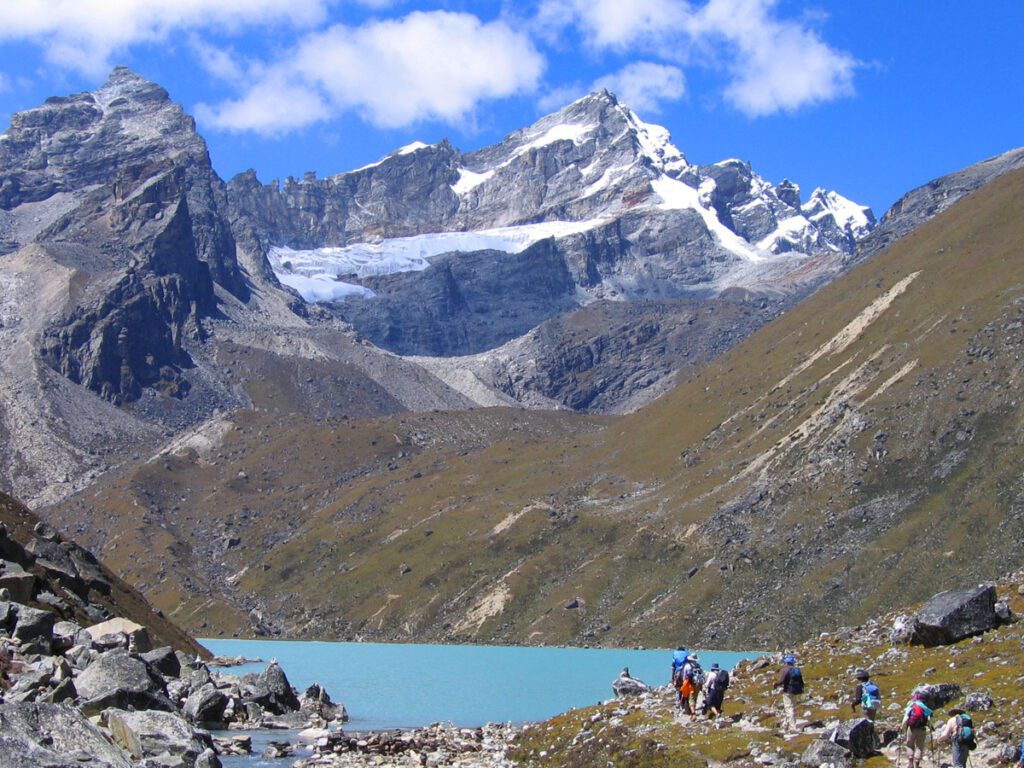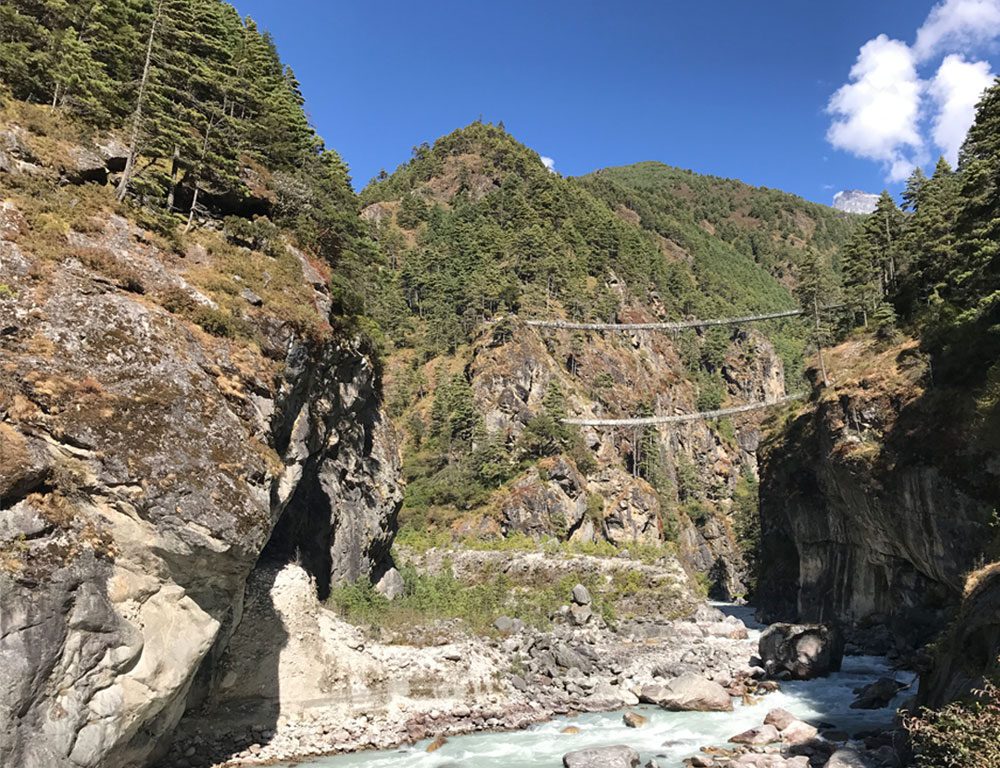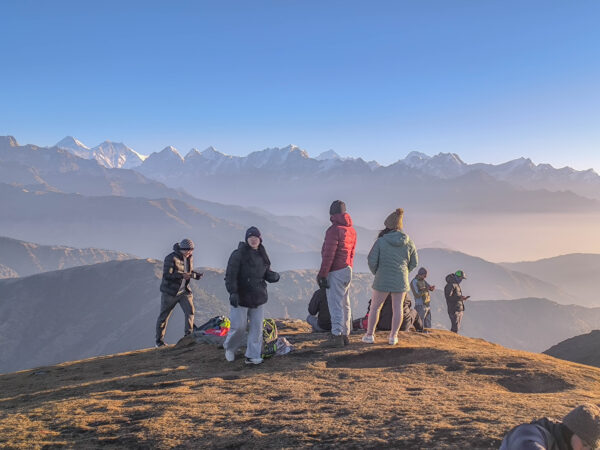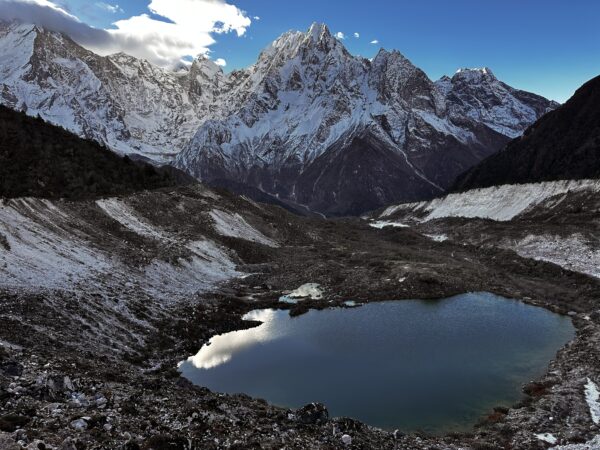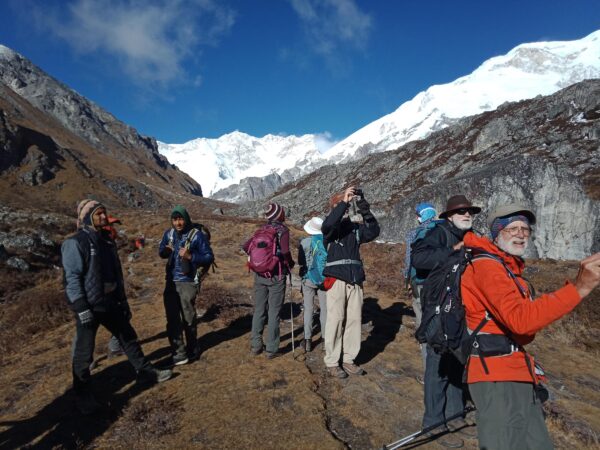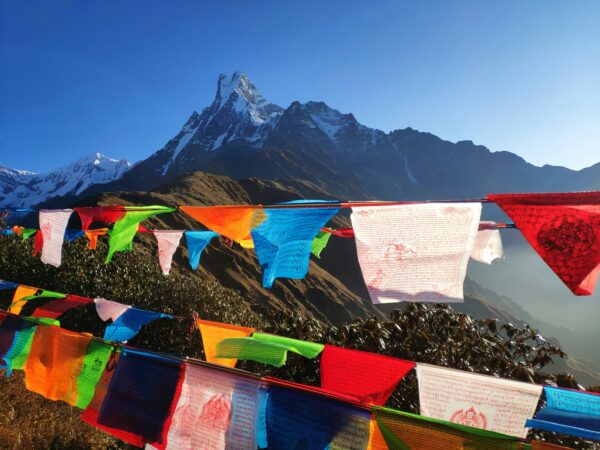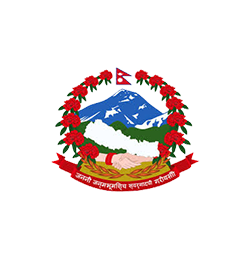The Everest Gokyo Ri Trek is one of the most enchanting journeys in the Himalayas—ideal for those looking to experience the Everest region without the hustle of the standard base camp trail. This 11-day adventure takes you deep into the heart of the Khumbu, leading you to the awe-inspiring turquoise Gokyo Lakes and the summit of Gokyo Ri (5,357 meters), where you’ll witness jaw-dropping views of Mount Everest, Cho Oyu, Lhotse, and the Ngozumpa Glacier—the largest glacier in Nepal.
Tucked between the Everest Base Camp trail and Thame Valley, the Gokyo region is often considered a hidden gem. Gokyo Ri lies at the crossroads of two stunning high passes—Renjo La and Cho La—offering panoramic Himalayan vistas and peaceful trekking trails that are less crowded yet equally rewarding.
Highlights
- Summit Gokyo Ri (5,357m) for Himalayan sunrise/sunset views
- Discover the surreal beauty of all Five Gokyo Lakes
- Optional side trip to the Fifth Lake or Ngozumpa Tse (5,553m)
- Experience Sherpa hospitality, cuisine, and mountain traditions
- Stay in cozy teahouses in Gokyo with heated dining rooms and private rooms
Can You See Mount Everest from Gokyo Ri?
Absolutely! Gokyo Ri offers one of the most breathtaking sunrise or sunset views in all of Nepal. From the summit, you’ll enjoy an unobstructed view of Mount Everest (8,848m), along with Lhotse, Makalu, Cho Oyu, and the serpentine Ngozumpa Glacier. The climb is well worth the effort, especially at dawn or dusk when the snow-capped peaks glow with shades of gold and copper.
Tip: Planning to hike for sunset? Don’t forget a headlamp or flashlight—descending in the dark without proper lighting can be dangerous.
How Difficult is the Gokyo Ri Trek?
This trek is considered moderate, suitable for trekkers with a reasonable level of fitness. Expect daily hikes of 5–6 hours. While it’s not technically demanding, the altitude and rugged trails can be challenging, especially during colder months when snow and ice may be present.
Preparing for the Gokyo Ri Trek
Physical Prep:
- Start cardio training (jogging, cycling, swimming) 3–4 weeks in advance
- Add strength training for your legs, back, and core
- Practice hiking with a backpack to simulate trail conditions
Essential Gear:
- Layered clothing (base, insulating, and waterproof)
- Down jacket, thermal wear, gloves, and hat
- Sturdy trekking boots + extra socks
- Trekking poles, headlamp, sunglasses, sunscreen
- Water purification tablets, personal first aid kit, and snacks
Health Tips:
- Drink plenty of water and eat well
- Take rest days for acclimatization
- Watch for symptoms of altitude sickness: headaches, nausea, fatigue
- Consult your guide if symptoms worsen
When is the Best Time to Trek Gokyo Ri?
The ideal seasons are:
- Spring (March to May) – Warm days and blooming rhododendrons
- Autumn (late September to November) – Crisp air and clear skies
Avoid the monsoon (June–August) and winter (late December to February), when trails may be muddy or snow-covered.
Outline Itinerary
Day 01: Fly to Lukla (2,843m – 35 minutes), trek to Phakding (2,640m – 3 hours). Overnight at lodge.
Day 02: Trek to Namche Bazaar (3,440m – 6/7 hours). Overnight at lodge.
Day 03: Acclimatization day in Namche Bazaar. Explore surroundings. Overnight at lodge.
Day 04: Trek to Dole (Approx. 5 hours). Overnight at lodge.
Day 05: Trek to Machhermo (3,820m – 5/6 hours). Overnight at lodge.
Day 06: Trek to Gokyo Lake (4,750m – 4 hours). Overnight at lodge.
Day 07: Hike to Gokyo Ri (5,483m – 4.5 hours) and visit Fifth Lakes. Overnight at lodge in Gokyo.
Day 08: Trek back to Dole (Approx. 5 hours). Overnight at lodge.
Day 09: Trek back to Namche Bazaar (Approx. 5 hours). Overnight at lodge.
Day 10: Trek to Lukla (Approx. 7 hours). Overnight at lodge.
Day 11: Early morning flight to Kathmandu (35 minutes)
Note: Want a hassle-free adventure? Let us take care of everything—from your arrival to departure, including Kathmandu hotels, guided sightseeing, and the full Gokyo Ri Trek. Just reach out to us, and we’ll handle the rest!
Tip: Domestic flights to Lukla are sometimes delayed or canceled due to unpredictable weather conditions. In such cases, taking a helicopter flight from Kathmandu to Lukla can be a reliable alternative. Although it is slightly more expensive than a regular flight, it ensures you stay on schedule. If you wish, we can arrange the helicopter for you under such circumstances.
Everest Gokyo Ri Trek – 11 Days - Itinerary
Fly to Lukla (2,843m) and Trek to Phakding (2,640m) – 3 hours
Your adventure begins early in the morning with a scenic 35-minute flight from Kathmandu to Lukla—an unforgettable experience with breathtaking views of the Himalayas. Once you land at Lukla's iconic airstrip, you'll meet your trekking crew and begin your journey through the Khumbu region. The trail is gentle on this first day as you walk for about 3 hours through charming Sherpa villages and pine forests along the Dudh Koshi River. You'll reach Phakding in the afternoon, where you'll rest and spend the night in a cozy mountain lodge.
Trek to Namche Bazaar (3,440m) – 6 to 7 hours
After a hearty breakfast, the trail continues north, crossing several suspension bridges adorned with colorful prayer flags. You'll pass through Monjo and enter Sagarmatha National Park before beginning the steep ascent to Namche Bazaar. This vibrant Sherpa town is the gateway to Everest and offers your first real taste of high-altitude trekking. The views of Everest and Lhotse along the way are simply spectacular. Tonight, you’ll rest in Namche at a comfortable lodge.
Acclimatization Day in Namche Bazaar
Today is all about giving your body time to adjust to the altitude. But don’t worry—it’s far from boring! After breakfast, you can take a short hike to the Everest View Hotel for panoramic views of Everest, Ama Dablam, and other Himalayan giants. You can also explore the local museum, visit the market, or relax at a local café with a cup of hot tea. Overnight again in Namche.
Trek to Dole (4,200m) – Approx. 5 hours
Leaving the buzz of Namche behind, the trail branches off from the main Everest Base Camp route and heads toward the quieter and equally stunning Gokyo Valley. You’ll pass through beautiful rhododendron forests, with occasional wildlife sightings (look out for Himalayan thar and musk deer!). After a scenic and steady climb, you’ll arrive in Dole—a peaceful settlement surrounded by towering peaks. Overnight in a mountain lodge.
Trek to Machhermo (3,820m) – 5 to 6 hours
Today’s trek follows a gentle climb up the valley, with stunning views of Cho Oyu—the sixth-highest mountain in the world. You’ll cross small streams and pass yak pastures before reaching the charming village of Machhermo. Legend has it this is where a Yeti once attacked a yak herd—ask a local about the story! You'll spend the night here, resting and preparing for the next day’s push to Gokyo.
Trek to Gokyo Lake (4,750m) – 4 hours
One of the most memorable days of the trek! The landscape opens up dramatically as you ascend beside the Ngozumpa Glacier—the longest glacier in Nepal. The final approach to Gokyo is simply stunning, with the turquoise waters of the Gokyo Lakes coming into view. These glacial lakes are sacred to both Hindus and Buddhists. You’ll arrive by midday, giving you plenty of time to relax and soak in the beauty of this magical place. Overnight in Gokyo.
Hike to Gokyo Ri (5,483m) and Explore the Fifth Lakes – Full Day
Start early for the challenging but rewarding climb up Gokyo Ri—a rocky peak with jaw-dropping panoramic views of four 8,000-meter peaks: Everest, Lhotse, Makalu, and Cho Oyu. The sunrise here is unforgettable! After descending, take a leisurely hike to the remote Fifth Lakes, with surreal landscapes and dramatic mountain backdrops. Return to Gokyo for the night.
Trek Back to Dole – 5 hours
Retrace your steps back down the valley, enjoying the views from a new angle. The descent to Dole is easier and quicker, and by now you’ll feel stronger and more acclimatized. Spend the night in a familiar lodge, sharing stories with fellow trekkers and enjoying a warm meal.
Trek Back to Namche Bazaar – 5 hours
Today you continue your return journey to Namche. With the downhill trail and the comforts of Namche calling, you’ll arrive with time to explore a bit more or simply relax at a local bakery with some fresh apple pie and coffee. Overnight in Namche.
Trek to Lukla – 7 hours
Your final day of trekking takes you all the way back to Lukla. It's a long walk, but filled with reflection and a sense of accomplishment. You’ll cross those familiar bridges one last time and pass through the villages you now know so well. Once in Lukla, celebrate your achievement with your guides and porters—it’s your last night in the mountains!
Fly Back to Kathmandu (35 minutes)
After an early morning flight from Lukla, you’ll be back in Kathmandu by mid-morning. You can spend the rest of the day relaxing, exploring the city, or treating yourself to a hot shower and a great meal in Thamel.
Inclusions
What's included
- International & Domestics Airport pick up and drop
- An Experience English speaking guide and porter (1 porter for every 2 trekkers)
- All Meals and Teahouse accommodation during the trek with attach room.
- Kathmandu to Lukla Flight Flight Ticket (Round Trip)
- All required trekking permits (Sagarmatha National Park Entry Fee and Pasang Lhamu Rural Municipality Entry Fee)
- Guide and porter insurance with food and accommodation
- Basic Medical kits
- Sleeping and duffel bag, down jacket, trekking poles (should be returned after the trek)
- Emergency Helicopter Evacuation Service Arrangement Only (should cover by your travel insurance)
- All required paper works and government taxes
- Farewell dinner
- Everest Hikes T-shirt
What's not included
- International Flight
- Nepal Travel Visa Fee
- Personal Medical and Travel insurance (Should cover helicopter evacuation)
- Guide, Porter and Driver tips
- Personal Gears (equipment)
- Personal bill
- Hotel in Kathmandu
- All other personal expense of beverages (hard and soft drinks)
- All other things not mentioned in the inclusion.
Accommodation at Gokyo Lakes
Teahouses in the Gokyo region are well-equipped and cozy, offering warm dining halls, twin-sharing rooms, and clean bathrooms. Trekkers typically spend two nights in Gokyo, allowing ample time to explore the nearby lakes and reach the summit of Gokyo Ri.
Permits Required
You don’t need a climbing permit for Gokyo Ri. However, two trekking permits are mandatory:
- Sagarmatha National Park Permit
- Pasang Lhamu Rural Municipality Entry Card
Distance & Elevation Gain
- Total trekking distance (round trip): 40–45 km (25–28 miles)
- Elevation gain from Gokyo (4,800m) to Gokyo Ri summit (5,357m): approx. 600m
- Time to summit: 2–4 hours up, 1.5–2 hours down
Alternative Routes & Side Trips
Feeling adventurous? Combine the Gokyo trek with:
- Renjo La Pass or Cho La Pass
- Everest Base Camp Trek
- Kongma La Pass and Chukhung Ri
- Visit Lawudo Gompa or hike to the Fifth Gokyo Lake
Travel with a Trusted Local Team
We the Everest Hikes, offers this 11-day Gokyo Ri Trek as part of a guided group adventure, led by experienced local guides and porters. Our package includes:
- Round-trip flights to Lukla
- All necessary permits
- Comfortable accommodations
- All meals during the trek
- Personalized support throughout your journey
Equipment
Recommended Trekking Gears
Clothing
- Base Layers (Moisture-Wicking)
- Thermal tops and bottoms (polyester or merino wool)
- Lightweight long-sleeve shirts
- Insulating Layers
- Fleece jacket or pullover
- Down jacket (for high-altitude treks)
- Warm sweaters
- Outer Layers (Shells)
- Waterproof and windproof jacket (Gore-Tex or similar)
- Waterproof pants
- Trekking Pants
- Quick-dry pants
- Convertible hiking pants (zip-off into shorts)
- Trekking Shirts
- Lightweight and breathable T-shirts
- Long-sleeve shirts with UV protection
- Headwear
- Wide-brim hat or cap for sun protection
- Warm beanie for cold temperatures
- Buff or scarf for dust and wind
- Gloves
- Lightweight trekking gloves
- Insulated gloves for higher altitudes
- Socks
- Moisture-wicking trekking socks
- Thermal socks for colder regions
- Footwear
- Sturdy and waterproof trekking boots (well broken-in)
- Comfortable sandals or camp shoes (for evenings/rest days)
- Gaiters (optional, for snow or muddy trails)
Backpacks & Bags
- Backpack
- 40-50L capacity for multi-day treks
- Comfortable straps and rain cover
- Daypack
- 20-30L for short treks or carrying essentials during the day
- Duffel Bag
- Used if porters are carrying your gear (for organized treks)
- Dry Bags
- To keep electronics and clothes dry in wet conditions
Sleeping Gear
- Sleeping Bag
- 4-season sleeping bag (rated for -10°C to -20°C for high-altitude treks)
- Sleeping bag liner (optional, for extra warmth and hygiene)
- Sleeping Pad (if camping)
- Lightweight and inflatable or foam pads for comfort
Trekking Accessories
- Trekking Poles
- Adjustable and lightweight poles (essential for steep ascents/descents)
- Water Bottle/Hydration System
- Insulated bottle (to prevent freezing at high altitudes)
- CamelBak or similar hydration reservoir
- Water Purification
- Water filters, purification tablets, or UV sterilizers
- Sunglasses
- UV protection (Category 3 or 4 for snowy conditions)
- Headlamp
- With spare batteries (essential for early morning or late-night treks)
- Multi-tool or Knife
- For various small tasks
- First Aid Kit
- Bandages, blister patches, antiseptic wipes, painkillers, Diamox (for altitude sickness), etc.
- Lip Balm
- SPF-protected to prevent chapping
- Sunscreen
- High SPF for UV protection at higher altitudes
- Personal Toiletries
- Biodegradable soap, toothpaste, toothbrush, quick-dry towel, wet wipes, and toilet paper
Optional but Useful Items
- Camera
- To capture the stunning scenery (extra batteries and memory cards are a must)
- Snacks
- Energy bars, trail mix, or chocolate for quick energy boosts
- Power Bank/Solar Charger
- For charging devices in remote areas
- Books or E-Readers
- For downtime during rest days
- Earplugs
- To block out noise in lodges or camps
- Notebook/Journal
- To record your trek experience
Clothing Packing Tips
- Layering is key: It helps regulate your body temperature and adapt to changing weather.
- Avoid cotton: It retains moisture and dries slowly, which can lead to discomfort or hypothermia.
- Pack light: Only carry what is absolutely necessary to avoid unnecessary weight.
Gear Rentals in Nepal
If you're worried about carrying too much gear, trekking hubs like Kathmandu and Pokhara offer trekking equipment rentals and sales. You can find items like sleeping bags, down jackets, and trekking poles at reasonable prices. However, ensure you check the quality before renting.

